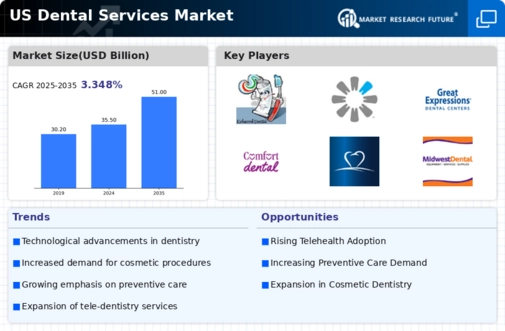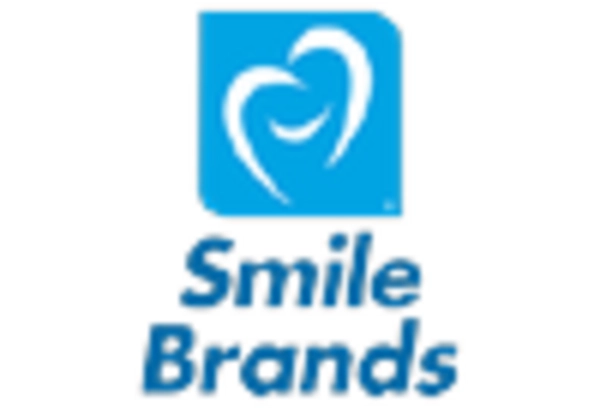The dental services-organization market in the US is characterized by a competitive landscape that is both dynamic and multifaceted. Key growth drivers include an increasing demand for dental care, advancements in technology, and a growing emphasis on preventive care. Major players such as Heartland Dental (US), Aspen Dental (US), and Pacific Dental Services (US) are strategically positioned to leverage these trends. Heartland Dental (US) focuses on expanding its network through acquisitions, enhancing its operational efficiency, and investing in digital solutions to improve patient experience. Meanwhile, Aspen Dental (US) emphasizes accessibility and affordability, often targeting underserved markets, which positions it favorably in a fragmented market. Pacific Dental Services (US) is notable for its commitment to innovation, particularly in integrating technology into practice management, which enhances service delivery and operational effectiveness. Collectively, these strategies contribute to a competitive environment that is increasingly shaped by technological advancements and patient-centric approaches.
In terms of business tactics, companies are increasingly localizing their operations to better serve regional markets, optimizing supply chains to reduce costs, and enhancing service delivery through technology. The market structure appears moderately fragmented, with numerous players competing for market share. However, the influence of key players is substantial, as they set benchmarks for quality and service standards, thereby shaping consumer expectations and competitive dynamics.
In October 2025, Heartland Dental (US) announced a strategic partnership with a leading telehealth provider to enhance its remote consultation capabilities. This move is significant as it aligns with the growing trend of digital health solutions, allowing Heartland to expand its reach and improve patient access to dental care. By integrating telehealth services, Heartland is likely to enhance patient engagement and streamline operations, positioning itself as a leader in the digital transformation of dental services.
In September 2025, Aspen Dental (US) launched a new initiative aimed at increasing dental care accessibility in rural areas by offering mobile dental units. This initiative is crucial as it addresses the disparities in dental care access, particularly in underserved regions. By bringing services directly to patients, Aspen Dental not only enhances its market presence but also reinforces its commitment to community health, potentially increasing patient loyalty and brand reputation.
In August 2025, Pacific Dental Services (US) unveiled a new AI-driven patient management system designed to optimize appointment scheduling and patient follow-up. This strategic move is indicative of the growing importance of technology in enhancing operational efficiency and patient satisfaction. By leveraging AI, Pacific Dental is likely to improve its service delivery, reduce wait times, and enhance overall patient experience, thereby solidifying its competitive edge in the market.
As of November 2025, current competitive trends in the dental services-organization market are heavily influenced by digitalization, sustainability, and the integration of AI technologies. Strategic alliances are increasingly shaping the landscape, enabling companies to pool resources and expertise to enhance service offerings. Looking ahead, competitive differentiation is expected to evolve, with a notable shift from price-based competition to a focus on innovation, technology integration, and supply chain reliability. This transition suggests that companies that prioritize technological advancements and patient-centric solutions will likely emerge as leaders in the market.

















Leave a Comment